Introduction – Modern and Historical Goths
Goths – the very name alludes to the chaotic times in continental Europe that derailed the existence of the Western Roman Empire. And while the Goths did play their part in the disintegration of the empire, their relevance as an ancient culture shouldn’t only be confined to the annals of Roman history.
Now talking of culture, in pop cultural references, ‘Goths’ are often used as a blanket term for a particular subculture with its own style of fashion and even music, starting out in the 1980s. The apparent ‘gloomy’ or ‘bleak’ theme of this subculture was possibly derived from 20th-century Gothic fiction (or Gothic horror) – a literary aesthetic of fear and haunting that was sometimes set in the backdrop of Gothic architecture.
Gothic architecture, in turn, was a pejorative term used to describe a particular architectural style with pointed arches, prevalent in Europe during the late Middle Ages from the 12th to 16th century. Giorgio Vasari, a renowned 16th-century Italian architect, put forth his indignant view of how the Gothic style structures were evocative of the ‘barbarous Germanic’ – thus alluding to the ancient Goths who exposed the Roman Empire.
But beyond biased categorizations, in this article, we will aim to delve into the origins, history, military, and culture of these historical ancient Goths – the Germanic warriors who had their incredible societal impact from the Danube to the Iberian peninsula (comprising Spain and Portugal).
Contents
- Introduction – Modern and Historical Goths
- Enigmatic Origins of the Goths
- The Dynamics of the Germanic Migrations
- The Germanic Warrior Culture
- The First Gothic Encounters with the Romans
- Gothic History – Influence of the Romans on the Goths
- Comitatus – The Elite Armed Band of Leaders
- The Ostrogoths and the Visigoths
- The Civil War of the Goths
- The Adrianople Affair
- The Chaotic Years of the 5th Century
- The Gothic Kingdoms
- The Appearance of Goths
- Military Equipment of the Goths
- The Religion and Language of the Goths
- Conclusion
Enigmatic Origins of the Goths
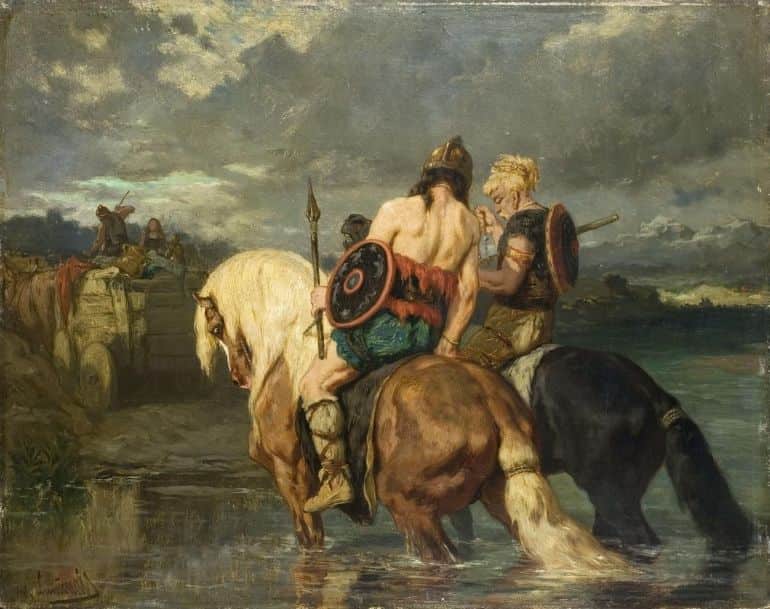
There is a certain element of mystery when it comes to the original homeland of the Goths. The primary reason relates to the scant documentation of Gothic history by ancient sources before their contact with the Roman Empire.
What historians can theorize is that the Goths as a people were mainly Germanic in origin, who in turn were influenced by the nomadic neighbors of the vast Eurasian steppe. Jordanes, a 6th-century Eastern Roman bureaucrat of possibly Gothic descent himself, talked about the possible Scandinavian origin of the Goths as follows –
Now from this island of Scandza, as from a hive of races or a womb of nations, the Goths are said to have come forth long ago under their king, Berig by name. As soon as they disembarked from their ships and set foot on the land, they straightaway gave their name to the place. And even today it is said to be called Gothiscandzan.
In this case, Scandza possibly refers to a region of Scandinavia, while the site Gothiscandzan possibly pertains to Gdansk in modern Poland. This hypothesis is rather reinforced by archaeological pieces of evidence, like the discovery of over 3,000 Goth tombs in Eastern Pomerania, Poland. A related conjecture puts forth the origin of the Gothic tribes in a region somewhere north of the Black Sea.
However, another school of thought in academic circles disputes such claims (relating to Scandinavian origin) based on the inexactness of Jordanes’ account and other Roman sources. Another hypothesis also pertains to how the ancient writer may have confused the histories of the Getae people (a Thracian tribe) and the Goths.
Modern scholarship has also argued that the archaeological evidence of Gothic history has been evaluated to fit in with Jordanes’ account, as opposed to a more independent assessment. So, in essence, while Goths can be (probably) termed as one of the ancient East Germanic people, their exact geographical origins (possibly somewhere from northern Europe) is still up for debate in academic circles.
The Dynamics of the Germanic Migrations
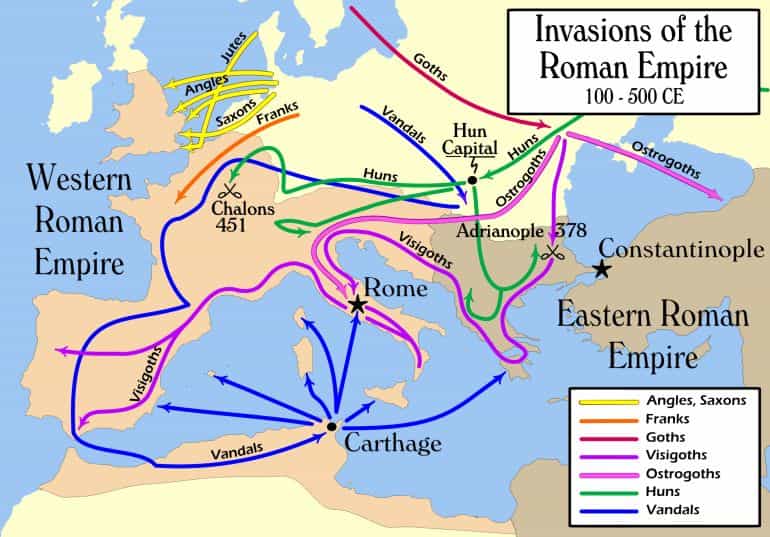
When it comes to categorizations in ancient history, the Goths, like their other contemporary Germanic brethren, can’t exactly be defined as a singular tribe. Now by the late 2nd century AD, the Roman Empire was indeed surrounded by various Germanic tribes who shared some common lexical borrowings and pantheons, but many of their languages were mutually unintelligible for the most part.
And between the 3rd century to 6th century AD, otherwise known as the Migration Period (sometimes classified as Völkerwanderung), the core tribal identities and relations of the Goths, like other Germanic entities, were relegated in favor of confederations.
Simply put, the Gothic tribal structure was eroded and instead replaced by a multinational character that aimed for united fronts (for protection) instead of ethnocentric preferences. One pertinent example would relate to the Visigoths, who also inducted Alans, Sarmatians, Taifals, Huns, and even Romans into their ranks.
Suffice it to say, these ‘Gothic tribes’ were influenced more by their immediate geography (that tended to change throughout the Migration Period) and proximate cultures rather than inherent tribal traditions when it came to fighting styles, clothing, and equipment.
For example, as noted by historian Simon MacDowall, Goths living on the near expanse of the Eurasian steppes had a tendency for cavalry-based combat – in contrast to their western cousins who served as mixed frontier forces within Roman-controlled territories of Eastern Europe.
The Germanic Warrior Culture
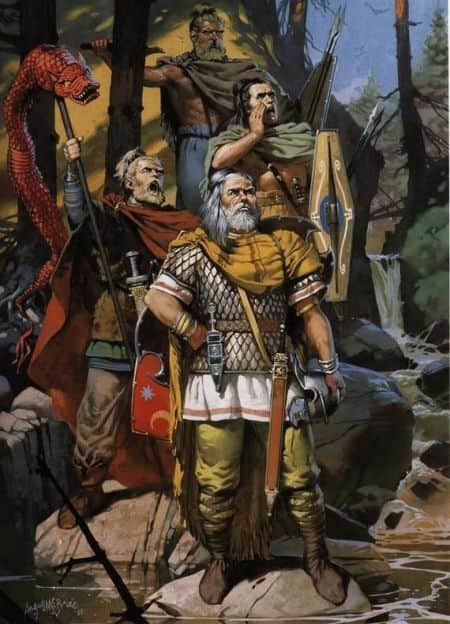
This is what Roman historian Tacitus had to say about the Germanic Warrior (sourced from the Germanic Warrior 236 – 568 AD by Simon MacDowall) –
A German is not so easily prevailed on how to plow the land and wait patiently for harvest as to challenge a foe and earn wounds for his reward. He thinks it spiritless to accumulate slowly by the sweat of his brow which can be got quickly by a loss of a little blood.
When not engaged in warfare they spend a certain amount of time in hunting, but much more in idleness, thinking of nothing else but sleeping and eating. For the boldest and most warlike men have no regular employment, the care of house, home, and fields being left to the women, old men, and weaklings of the family. In thus dawdling away their time they show a strange inconsistency – at one and the same time loving indolence and hating peace.
Now while such a characterization is undoubtedly biased (given the early Roman disdain for ‘barbarians’), it does provide a glimpse of an insight into the psychological aspect of warfare in Germanic tribe systems and Gothic history. In essence, warfare was perceived as a ritualistic extension of culture, as opposed to viewing it as a strategic conflict between life and death and total destruction.
To that end, in the phase before the migrations, the tactical scope of battles was kept short and simple, with emphasis on localized conflicts and revenge-fueled raids. Such clan-based encounters in the society of Goths were pretty common and as such kept the warlords, chieftains, leaders, and their armed retinues in a relative state of battle readiness.
The First Gothic Encounters with the Romans
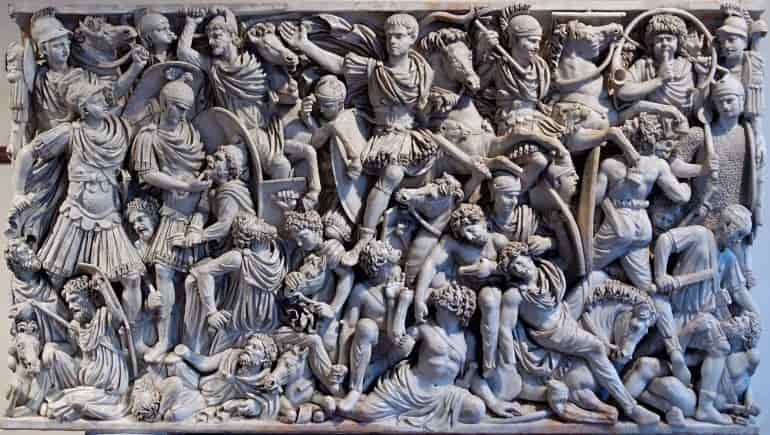
The first known incursion (or invasion) of the Goths into the erstwhile Roman Empire took place circa 238 AD – when the roving bands of the former attacked the city of Histria in what is now modern-day Romania (at the mouth of the river Danube). The motivation for such an assault is unknown to historians, with hypotheses relating to how such forays were made to ‘test’ the already weakened Roman defenses.
It might have been also the case where such Goth raiding forces acted as vanguards to their migratory bands. Consequently, the Goths began their incursions to establish political leverage over the Romans – who were already going through the Crisis of the Third Century.
In an interesting turn of events, according to documentation made by a 3rd-century Athenian author Dexippus, there was a battle at Thermopylae, where Greek defenders (under Roman rule), like their Classical predecessors, tried to defend the famous mountain pass, this time against the Goths, some time in circa 250-260 AD. As Dexippus wrote –
Some [of the Greeks] carried small spears, others axes, others wooden pikes overlaid with bronze and with iron tips, or whatever each man could arm himself with. When they came together, they completely fortified the perimeter wall and devoted themselves to its protection with haste.
On the other hand, the Romans were also beginning to induct some of the Goths into their own army (as early as 244 AD, since Goths took the field in the Roman-Persian battles), possibly as a means to assuage the Germanic invaders – with promises of riches and plunder.
And recent historical analysis rather challenges the typical view that Goths, along with other Germanic entities, continuously made large-scale forays into the Roman territory that ultimately led to the downfall of the Western Roman Empire. As historian Walter Goffart mentioned –
According to the traditional schema, the Germanic peoples had been in motion since the third or first century B.C., engaging in periodic mass migrations that pressed northern tribes down upon earlier emigrants to the south with such increasingly disruptive force that the Roman frontier, which had impeded the migrant’s progress for several centuries, was torn down around A.D. 400.
The moving Germanic masses then surged forward and halted in the imperial territory. Yet this final step turns out to be remarkably modest: those involved in it were a mere handful of people, each group numbering at the most in the low tens of thousands, and many of them – not all – were accommodated within the Roman provinces without dispossessing or overturning indigenous society.
Gothic History – Influence of the Romans on the Goths
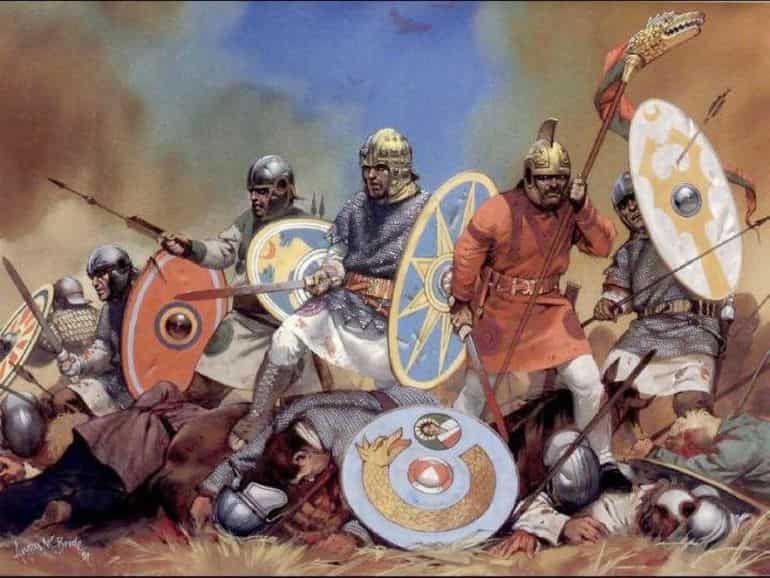
Now, while the Goths were more or less neutral to the Romans before circa 238 AD, the incursion at Histria made them one of the primary players in the Roman fields of politics and military – from the mid-3rd century till 400 AD.
According to most historians, with the passage of time, a significant percentage of the population in the Roman world during this period (possibly) was of Gothic extraction (or rather an ancestry). These groups mostly settled and served in the frontier regions as ‘Roman soldiers’ in a subsidized system known as the foederati.
At the same time, they did retain a good part of their Gothic culture, thereby creating a patchwork of ‘semi-Germanized’ frontier states that were more akin to autonomous fiefs rather than Roman garrison towns. It should also be noted that these ‘Roman’ Goths co-existed and fought with the ‘original’ Goths who tended to settle and move across their own ancestral lands outside the Roman borders.
Now from the perspective of history, this complex scope often overlapped and was dynamic in nature. For example, in the various stages of settling inside Roman territories (as foederati), few Gothic and other Germanic chieftains, as semi-independent Roman officers, accumulated wealth beyond their own expectations and then returned to the tribal fold outside of Roman influence.
Once out of the Roman sphere, they gathered their warbands, tactically reinforced by the Roman-style of command chains and backed by newly acquired wealth, to further attack and subdue other relatively unprotected frontier regions (inside Roman territory).
Comitatus – The Elite Armed Band of Leaders
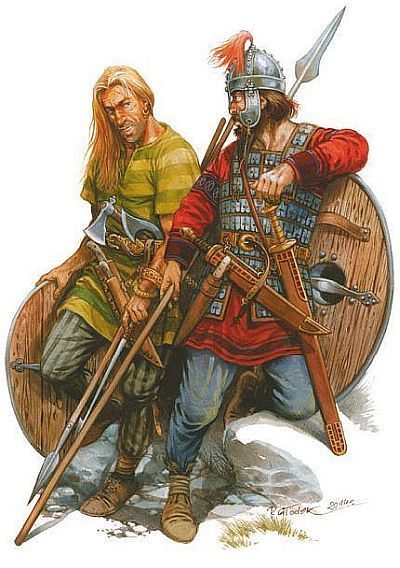
The concept of organizational hierarchy was rather vague in Germanic tribes, especially with their notions of land being held collectively by freemen. This translated to a scenario where the Gothic leader or chieftain, often an esteemed warrior (and the first among equals), had his immediate household members and weapon-wielding retainers as the available troops who sporadically engaged in warfare and raids – bound by oaths of loyalty.
But as we mentioned before, the Roman influence rubbed rather heavily on the newly settled Goths, who were beginning to employ hierarchical command chains, albeit in simpler forms, to organize structured warbands.
Essentially, the warrior-chieftains were gradually replaced by men of affluence, thereby suggesting how wealth (as opposed to tribal connections) was an important marker when it came to gathering followers. The core group of these followers, known as the comitatus, often comprised well-armed young men and veterans who came from various clans and even ethnicities, thus eroding the tribal structure of the old.
To that end, fighting men of such ‘mixed’ ancestry, employed and encouraged by their respective wealthy leaders formed the warrior aristocracy of the Romanized Goths in the frontier regions – and they expected gifts and plunder in return for their loyalty.
Unsurprisingly, these semi-professional retainers bore the brunt of the fighting and even conquered other proximate territories. Meanwhile, the ‘traditional’ Romans were left relatively unharmed in charge of civic administrations, especially since conflicts tended to be of a smaller scale in 4th-5th century continental Europe.
The Ostrogoths and the Visigoths
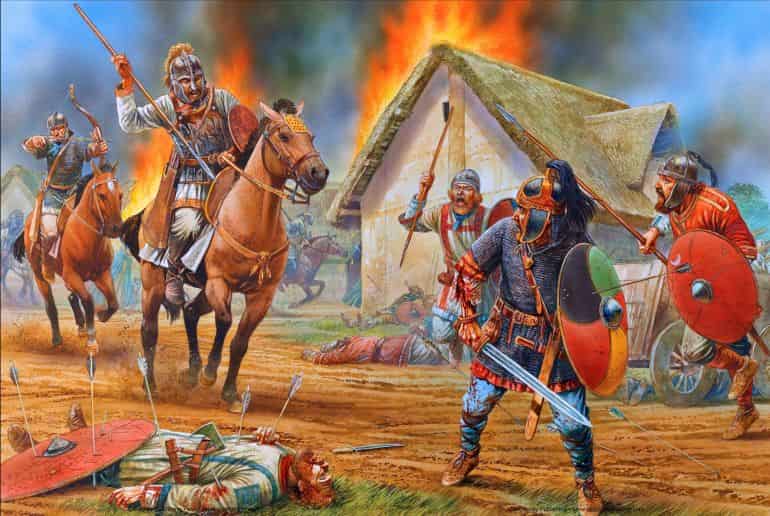
Previously, in the article, we mentioned how during the roughly 160-year period between 240 – 400 AD, the Goths existed as two separate though not entirely segregated groups – the semi-Romanized Goths who mostly served as Roman frontier soldiers (with their settled families) and the ‘independent’ Goths who still lived in the vicinity of their ancestral homelands.
The former Roman-influenced Goths were known as the Thervingi – and by the 5th century AD, most elements (although not all) from this group formed the Visigoths. The Goths living largely outside of the traditional Roman borders, mostly between the Baltic and the Black Sea, were known as the Greuthungi, and likewise, most of them formed the core elements of the Ostrogoths in the 5th-6th century.
Now considering the dynamic nature of migrations and settling, along with localized conflicts and the domino effect of external pressures, we should once again emphasize that there were members of the Thervengi who sided with the Ostrogoths and vice versa (like Greuthungi serving with the Roman-influenced Thervengi). For example, Odoacer (433-493 AD), the first king of Italy, may have been an Ostrogoth (or from a different branch of Goths) who maintained his primarily Visigothic army.
Moreover, the very terms were probably coined in the 6th century by Cassiodorus, who went on to vaguely categorize Ostrogoths as ‘eastern Goths’ and Visigoths as ‘western Goths’. And lastly, there were also other Gothic communities spread across Illyria, lower Balkans, and even Anatolia – under the jurisdiction of the eastern half of the Roman Empire (later to become the Eastern Roman Empire in circa 395 AD).
The Civil War of the Goths
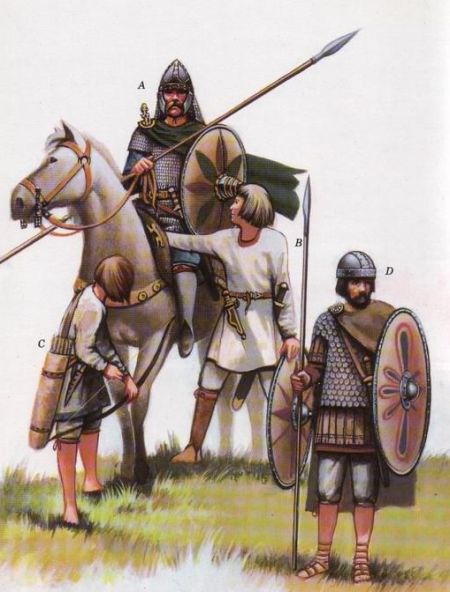
The catalyst for the major Gothic movements throughout the Roman territories in the 5th century AD was fueled by the civil war within the Thervengi ranks. Among the two factions at odds here, one belonged to Athanaric, who was the reiks (‘rix’ or judge), a traditional king-like figure for the Thervengi Goths, and the other belonged to Fritigern, a Roman-allied commander of the Goths.
Athanaric, possibly by virtue of his symbolic position, preferred his domains outside of Roman control. To make matters complicated, he openly advocated his Germanic pagan religion and as such considered himself a sworn enemy of the Christian Romans.
On the other hand, Fritigern, not only counted himself as a Roman ally (based in Thrace) but also took up the mantle of Arian Christianity (possibly under the influence of Ulfilas the Goth, the missionary who devised the Gothic alphabet) – the very same religion followed by the contemporary Roman Emperor Valens.
Athanaric drew the proverbial first blood by defeating Fritigern in open battles, which forced the latter to seek direct support from the Romans. Valens, being an Arian Christian himself, dutifully intervened circa 367-369 AD.
Politically, this was a part of the greater power struggle that also involved the Greuthungi king Ermanaric. Ermanaric was a powerful ruler who controlled a vast swathe of lands from the Baltic Sea to the Black Sea and as such considered Athanaric as his loyal pagan tributary.
In the ensuing campaign, the Romans, while suffering significant casualties, finally managed to subdue Athanaric in his mountainous stronghold, incidentally aided by the arrival of another ‘super tribe’ – the Huns. This led to a timely treaty between Athanaric and Valens, possibly conducted on a boat on the Danube (neutral zone), while the near future was to be affected by the momentous Hunnish pressure on continental Europe.
The Adrianople Affair
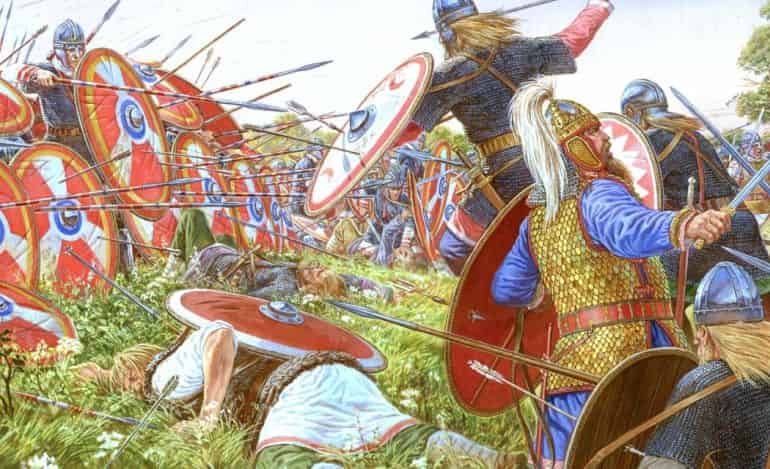
The formidable onslaught of the Huns, whose origins are almost as mysterious as that of the Goths, claimed the Alans, a probably Iranic (with Germanic elements) tribe as the first victim. Their next target pertained to the Greuthungi Goths, with ancient sources mentioning how the pressure was so high on the aforementioned king Ermanaric that he had to resort to suicide.
Finally, the Huns approached near the borders of the Roman Empire and started to coerce the frontier Thervengi Goths, still under the nominal leadership of Fritigern (since his rival Athanaric failed to protect the Thervengi from the roving bands of Huns and Alans).
Fritigern expectedly appealed for aid from the Roman emperor Valens, this time in the form of asylum within Roman borders. And Valens once again permitted his ally’s request by allowing the Thervengi to cross the Danube, in circa 376 AD. Consequently, many Goths settled across the great river, leading to significant changes in the demographics of the region.
Unfortunately, for both parties, the local Roman administrators possibly mistreated the Gothic refugees, including the women and children. According to Ammianus, the 4th-century Roman soldier, and historian, the administrators (including a dux) were not only incompetent but also ‘greedy’ by selling already scarce food to the desperate Goths at inflated prices.
The situation became even more complicated when some bands of the Greuthungi Goths, still hounded by the Huns, tried to join their brethren across the Danube. And finally, the dissent rose to a full-scale armed rebellion after an unsuccessful assassination attempt on many of the Gothic leaders.
Thus the First Gothic War pitted the already frenzied Goths, who had their numbers but were relatively disfranchised, against the Romans having their advantage in logistics but lacking determined troops.
For the next two years, even Valens was forced to join the fray against his old allies, but neither side achieved an outright victory. All of that changed at the Battle of Adrianople in 378 AD, with the (possibly outnumbered) Gothic army scoring a stunning victory over the Romans personally led by Valens. In a cruel twist of fate, the Roman emperor anonymously met his demise on the battlefield.
The Chaotic Years of the 5th Century
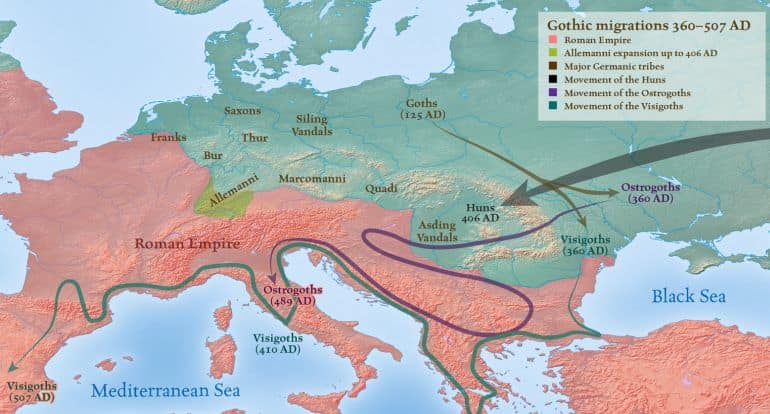
Valens’ successor Theodosius I (also known as Theodosius the Great) managed to pacify the Goths by offering them even more subsidies (and territories) to join the Roman army and in some cases even buy them off. As a result, most Gothic elements, while still managing to retain a significant part of their Germanic culture, were embedded deep within Roman territories essentially as a ‘different’ people.
This unique political scope was rather mirrored by how the Romans perceived the Goths as threatening entities who were either to be appeased or to be restrained, but never to be ignored.
By the 5th century, the divisions among the Goths were also becoming more pronounced, with the foederati Goths (mostly of the Thervengi stock) south of the Danube being increasingly identified as the Visigoths. After suffering heavy casualties in a subsequent Roman civil war and then once again being treated in an underhanded manner by their Roman commanders, these people were roused to yet another rebellion led by Alaric I – the king of the Visigoths. The episode culminated in the disastrous sacking of Rome itself circa 410 AD.
A few decades later, a familiar menace came in the form of the ferocious Huns, this time led by Attila, and their relentless armies devastated continental Europe, including the Balkans, Gaul, and even Italy, from 444 AD till Attila’s death in 453 AD.
To make things even more convoluted, the Hunnic army was supported by the remnants of many ‘outer’ Goths (mostly of the Greuthungi stock), who were primarily identified as the Ostrogoths. Many Crimean Goths also joined the super-tribe structure of the semi-nomadic Hunnic forces.
The Gothic Kingdoms
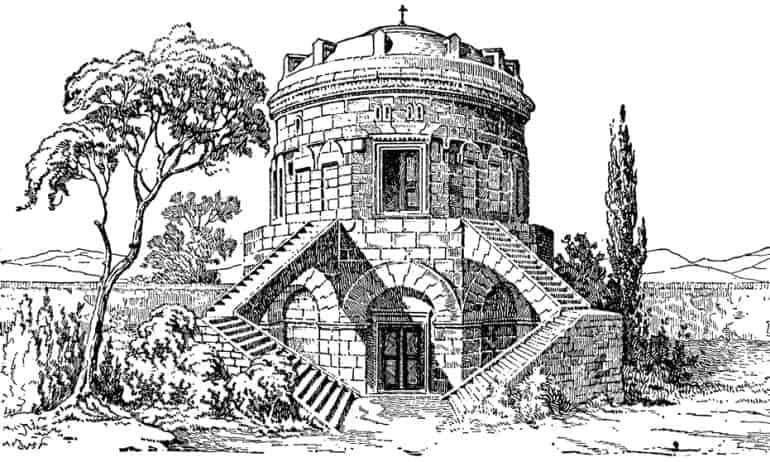
The threat of the Huns was stymied by the momentous Battle of the Catalaunian Fields (circa 451 AD), where the Romans scored a pyrrhic victory, while the Goths, along with other Germanic tribes like the Franks and the Alemanni, served on both sides of the encounter.
However, by this period, the Roman Empire was perilously weakened, especially with its eastern half (the Eastern Roman Empire or Byzantine Empire) already ‘inheriting’ many rich territories and a separate royal court at Constantinople, the largest city in Europe at the time.
The Western Roman Empire, in contrast, had its political structure eroded by a variety of factors, including external threats and internal incompetence, thereby ‘leaking’ even more autonomous powers to the Germanic foederati like the Goths.
Unsurprisingly, the fractured empire was soon consumed (or simply taken over) by the gradually-settling Germanic factions. Thus the Goths established their independent kingdoms across the western part of continental Europe, like Italy, Gaul (France), and Iberia (Spain and Portugal). In Italy, the primarily Visigothic elements were relegated in favor of the Ostrogoths (by circa 493 AD) who had successfully broken away from their Hunnish overlords.
Theodoric, the King of the Goths in Italy, even went on to rekindle a part of the olden Roman legacy in the fields of legal administration and architecture, with the cultural revival centered in the city of Ravenna. However, the Ostrogothic Kingdom of Italy only survived till 553 AD and was conquered by Belisarius, the proficient general of the Eastern Roman Empire.
By the sixth century, the Visigoths in France were also defeated and assimilated by the combined forces of the Franks and Burgundians. On the other hand, the Visigothic Kingdom of Iberia, the last Gothic kingdom, survived till the early 8th century AD – and they were finally overcome by the Islamic armies from North Africa.
The Appearance of Goths
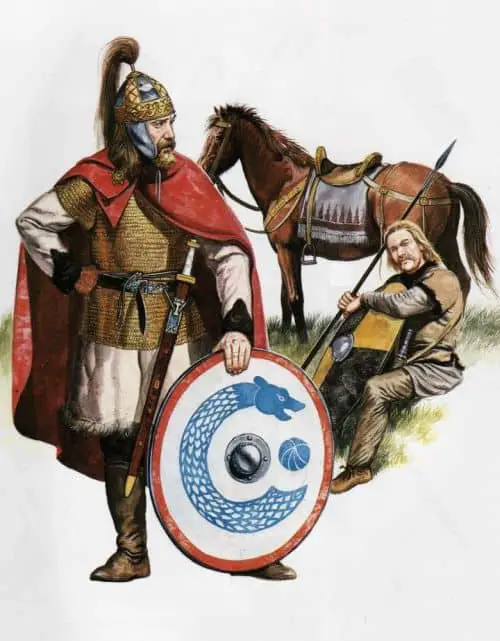
As historian Simon MacDowall noted, during the Migration Period, the typical veteran Germanic warrior had a penchant for displaying his acquired wealth on the person. This translated to brightly colored clothes complemented in equal measure by armor, accessories, and weapons – including richly-hued patterned garments, belts (a marker used for a warrior), swords, helmets, axes, and shields.
Beneath this ostentatious veneer, a Goth preferred his ubiquitous tunic and trousers, often accompanied by a cloak (determined by the weather). The clothing was mostly made from linen or wool and sometimes from a mix of the two.
Interestingly enough, according to a description of Sidonius Apollinaris, the Gallo-Roman poet, author, and diplomat of the 5th century, the Franks (and by extension, other Germanic people like the Goths) possibly aimed for relative uniformity in their comitatus, with the veteran warriors often flaunting their green or crimson mantles along with gold or silver patterned shields.
Moreover, we should also take note of the influence of proximate cultures – for example, the Visigoths living within and near the Roman borders probably adopted the Roman style of clothing, while their Ostrogoth brethren may have preferred the loose-fitting tunics of the steppe nomads.
Military Equipment of the Goths
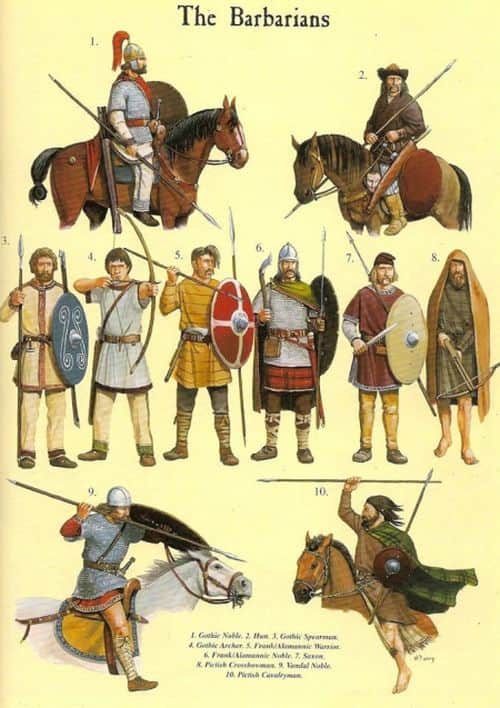
The sword, among the Goths and other Germanic entities, was often perceived as a weapon of high status, while the lowly (but effective) spear was seen as the weapon of choice for the ‘commoner’ infantrymen.
Moreover, in Gothic culture, the bow was also relegated to the poorer sections of society, thus alluding to how melee fighting was still considered the ‘bastion’ of noble warriors. Given this Germanic cultural affination for direct combat, we can certainly theorize how the comitatus and household retinues of the chieftains and warlords flaunted their high-quality weapons and armor.
To that end, while early Roman authors, like Tacitus, were clearly not impressed by the ‘barbarians’, later authors like Ammianus, made no distinction between the equipment quality of the Romans and the Goths. In fact, he went on to mention how some of the Goths were rather weighed down by their heavy arms at the decisive Battle of Adrianople.
In that regard, historians have hypothesized that the workmanship of some Germanic smiths perhaps even outclassed their Roman contemporaries – as suggested by archaeological evidence of smelting furnaces and funerary items.
Now, of course, such high-quality equipment was probably only furnished in small quantities, tailored to the requirement of the chieftain’s retinue, while most of the Roman troops were equipped with the mass-produced weapons of the fabricae (arms factories).
As for armor, chainmail (or ring mail) was the common type of protection used by the affluent members of the 4th-5th century Visigothic comitatus, often complemented by the spangenhelm helmet. The other steppe-inspired Goths (like Ostrogoths) may have preferred their scale-mail corselets and javelins while fighting atop horses.
The Religion and Language of the Goths
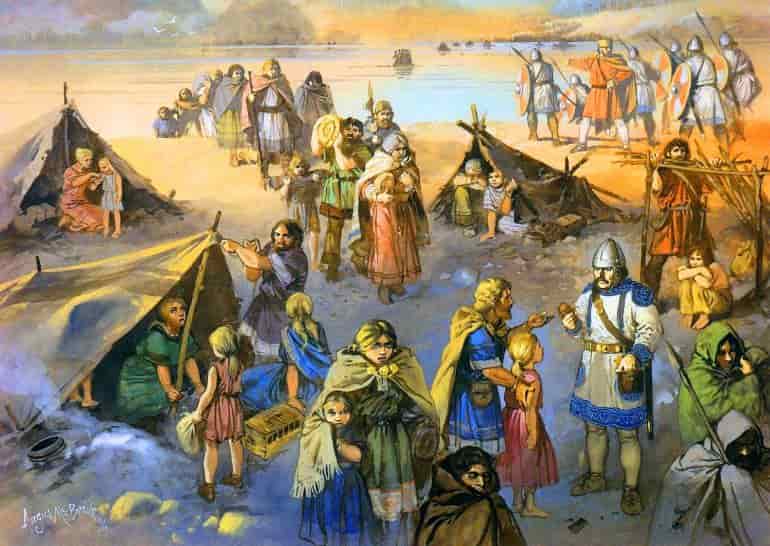
As we fleetingly mentioned before in the article (see entry 8), the Goths, like most Germanic tribes, originally practiced their form of Nordic paganism – based around a pantheon of common Nordic entities (like Wōtan or Odin), ancestral worship, and natural cycles, with the primary lore being borrowed from a patchwork of oral traditions and local tales that were conceived in pre-Christian ancient Germania.
Later on, a branch of the Thervengi Goths, under Roman influence, probably adopted Arian Christianity in the late 4th century, while the majority of the Greuthungi still clung to their pagan religion possibly till the 5th century.
Pertaining to Christianity, it was Ulfilas the Goth (or Wulfila – ‘little wolf’), a 4th-century missionary, who was responsible for translating the Bible from Greek into what we know as the first known record of the written Gothic language. Similar to Teutonic, the written form was based on the Gothic runes while being inspired by the Greek uncial script.
Conclusion
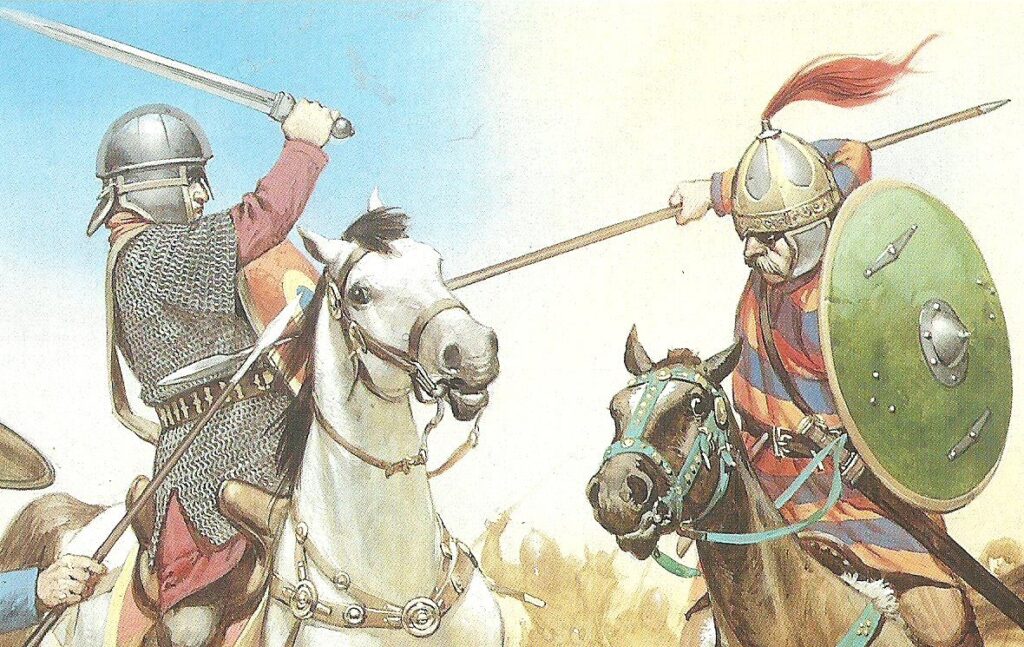
And talking of Greek and Roman influence, while scholars do consider that the Goths played their role in the demise of the Western Roman Empire, this role has probably been unfairly exaggerated and obstinately detested (since on an objective level, the Germanic confederations only filled the power vacuum left behind by the already fractured Roman state in the 5th century AD).
To that end, in a rather ironic twist, the Goths also tried to preserve the legacy of the Roman institutions – in both the Kingdom of Italy under Theodoric and the Iberian Kingdom under the Visigoths, thus in many ways paving the way for the later European emergence from the proverbial Dark Ages.
Featured Image Credit: Fall3NAiRBoRnE (deviantART)
Book References: Germanic Warrior 236 – 568 AD (by Simon MacDowall) / History of the Goths (by Herwig Wolfram)
And in case we have not attributed or misattributed any image, artwork or photograph, we apologize in advance. Please let us know via the ‘Contact Us’ link, provided both above the top bar and at the bottom bar of the page.
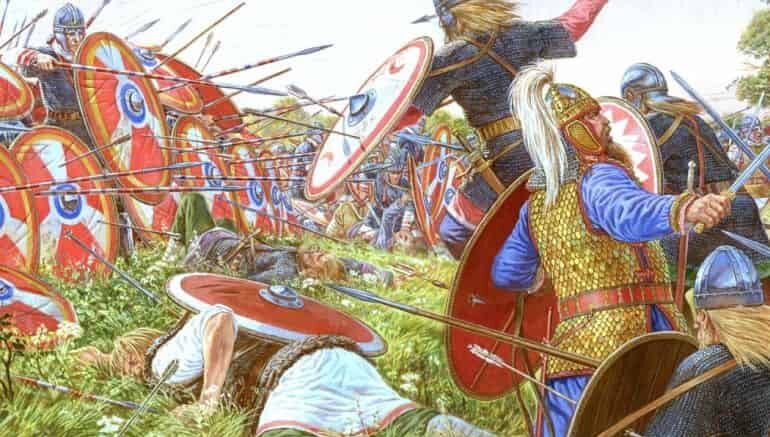


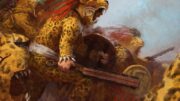

Be the first to comment on "Goths: The Ancient Germanic Warriors Who Exposed The Roman Empire"